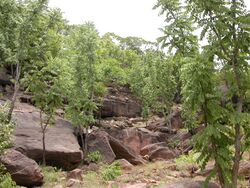Biology:Pericopsis laxiflora
| Pericopsis laxiflora | |
|---|---|

| |
| Scientific classification | |
| Kingdom: | Plantae |
| Clade: | Tracheophytes |
| Clade: | Angiosperms |
| Clade: | Eudicots |
| Clade: | Rosids |
| Order: | Fabales |
| Family: | Fabaceae |
| Subfamily: | Faboideae |
| Genus: | Pericopsis |
| Species: | P. laxiflora
|
| Binomial name | |
| Pericopsis laxiflora (Benth. ex Baker) Meeuwen
| |
Pericopsis laxiflora is a woody deciduous shrub or tree within the Fabaceae family. Sold commercially as satin wood,[1] it is known in some regions as Kulu Kulu,[2] among the Hausa speaking people, it is called Makarfo, the Yorubas call it Ayan and the Igbos call it Abua-Ocha.[3] It is one of three species in the genus Pericopsis genus that occurs in Africa.
The species contains the alkaloids: N-methylcytisine, ammodendrine, and choline.[4]
Description
A tree or shrub, common growth reaches between 9 and 12 meters[citation needed] tall but occasionally grows up to 2 meters tall as a shrub.[citation needed] Trunk usually twisted, rarely straight and with twisted branches, bark is smooth, grey to beige in color while stem is pubescent. Leaves, alternate arrangement, 4 - 6 pairs, upper surface imparipinate, shiny and lower surface glabrous.[5] Leaf-blade, lanceolate to ovate in outline, 3 – 7 cm long and 2.5 – 5 cm wide, acuminate apex with cuneate base. Petiole, 15 – 20 cm long.[5]
Distribution
Occurs widely in the Savannah and dry forest regions of West Africa.[6]
Uses
Root, bark, leaf decoctions are used to treat stomach ailments in Côte d'Ivoire, while in Guinea, plant extracts are used to treat shigellosis. In Ghana it is used as a topical treatment for body pain and among some locals in Cameroon, the plant extracts are used by diabetes patients.[citation needed]
References
- ↑ Fitzgerald, Maurice A.; Gunning, Peter J. M.; Donnelly, Dervilla M. X. (1976). "Phytochemical examination of Pericopsis species" (in en). Journal of the Chemical Society, Perkin Transactions 1 (2): 186–191. doi:10.1039/p19760000186. ISSN 0300-922X. http://xlink.rsc.org/?DOI=p19760000186.
- ↑ Tringali, Corrado (1995). "Identification of bioactive metabolites from the bark ofPericopsis (Afrormosia) laxiflora" (in en). Phytochemical Analysis 6 (6): 289–291. doi:10.1002/pca.2800060603. https://onlinelibrary.wiley.com/doi/10.1002/pca.2800060603.
- ↑ Fadipe, L. A.; Babayi, H.; Anselm, O. A. (2019-12-14). "Isolation and in-vitro assessment of two indole alkaloids from Pericopsis laxiflora leaf extract for their antibacterial potentials" (in en). Journal of Chemical Society of Nigeria 44 (7). ISSN 0795-2066. http://journals.chemsociety.org.ng/index.php/jcsn/article/view/419.
- ↑ Forestieri, A. M.; Monforte, M. T.; Ragusa, S.; Trovato, A.; Iauk, L. (1996). "Antiinflammatory, Analgesic and Antipyretic Activity in Rodents of Plant Extracts used in African Medicine" (in en). Phytotherapy Research 10 (2): 100–106. doi:10.1002/(SICI)1099-1573(199603)10:2<100::AID-PTR724>3.0.CO;2-I. ISSN 1099-1573. https://onlinelibrary.wiley.com/doi/abs/10.1002/%28SICI%291099-1573%28199603%2910%3A2%3C100%3A%3AAID-PTR724%3E3.0.CO%3B2-I.
- ↑ Jump up to: 5.0 5.1 Arbonnier, Michel; Arbonnier, Michel (2004) (in English). Trees, shrubs and lianas of West African dry zones. CIRAD. pp. 321. ISBN 978-3-8236-1419-7. OCLC 249767040. https://www.worldcat.org/oclc/249767040.
- ↑ Haruna, A. K. (2000). "Depressant and anticonvulsant properties of the root decoction of Afrormosia laxiflora (Leguminosae)" (in en). Phytotherapy Research 14 (1): 57–59. doi:10.1002/(SICI)1099-1573(200002)14:1<57::AID-PTR538>3.0.CO;2-V. ISSN 1099-1573. PMID 10641052. https://onlinelibrary.wiley.com/doi/abs/10.1002/%28SICI%291099-1573%28200002%2914%3A1%3C57%3A%3AAID-PTR538%3E3.0.CO%3B2-V.
Wikidata ☰ Q6072455 entry
 |

